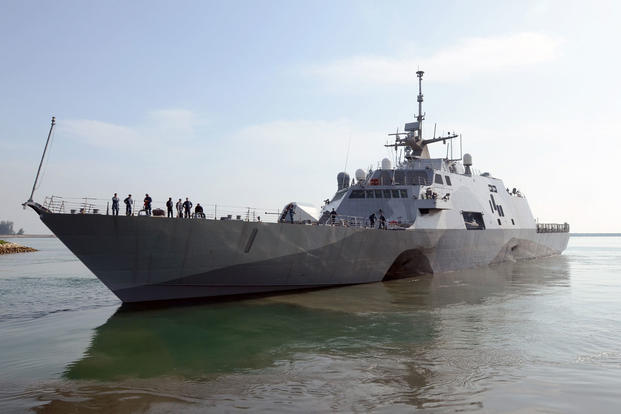QUANTICO, Virginia --The Navy's newest surface ship could carry contingents of Marines in the not-too-distant future, according to a new operating concept released by the Marine Corps this week.
While the Corps has long promoted the concept of Marines deploying on non-traditional vessels and seabasing platforms, the new Marine Corps Operating Concept further opened the aperture, describing a future in which troops take on a broader role in maritime security, counter-piracy operations, and sea control aboard smaller surface ships, including the littoral combat ship and future frigates.
"Navy and Marine Corps units can be task-organized to provide scalable and distributed options to defeat land-based threats with the forcible entry capability provided by up to two [Marine Expeditionary Brigades], deny enemy use of key maritime areas or terrain, or establish [expeditionary advance bases]," the document states.
Marine planners are tasked with ways to increase the use of Marines on warships including the LCS, future frigate, and Arleigh-Burke Class guided-missile destroyers, as well as on seabasing platforms such as the expeditionary mobile base and T-AKE dry cargo ship. The document also calls for development of a concept of operations that will describe the way the distributed Marine air-ground task force must operate in the future to support naval operations.
Commandant Gen. Robert Neller told Military.com on Wednesday at the Modern Day Marine expo that he believed the service needs to be more open to operating on platforms other than traditional amphibious ships.
"We're part of the naval team, so there may be missions where putting a small Marine detachment on a surface craft like … LCS is advantageous, a vehicle to do maritime interdiction of other ships, to board, search or seize other ships, to do small raids," Neller said. "It's more a mission of opportunity."
Neller said he didn't see the Corps returning to the ship detachments of the past as it considers operating off a wider range of platforms.
But, he said, "if the [Amphibious Ready Group/ Marine Expeditionary Unit] is out there, Marines in the vicinity are training or deploying, and there's a requirement that they needed a landing team or a landing force on a small ship, certainly we should be able to do that."
The Navy's littoral combat ships, which began entering service in 2008, are designed to combat asymmetric and anti-access threats near the coastline. The ships have faced criticism over reports that questioned the vessels' survivability, compared to other warships. A 2015 Government Accountability Office report found "the lethality and survivability of the LCS is still largely unproven," citing concerns about the strength of the hull and unknowns about how the ship would fare in an underwater explosion.
An upcoming survivability upgrade will transform the LCS program into the future frigate, arming the ship with more weapons and likely including retrofits for the ships already in service. The process of building and fielding the future frigate is expected to begin after 2018.
-- Hope Hodge Seck can be reached at hope.seck@military.com. Follow her on Twitter at@HopeSeck.
Related Video:



























